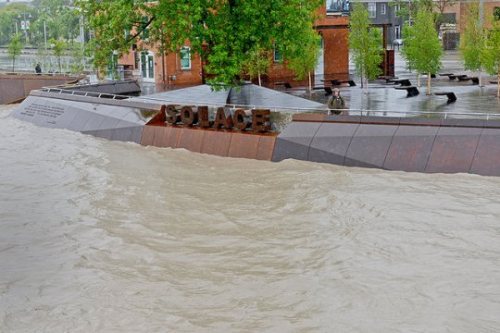
Andrea Germanos, June 24, 2013, Common Dreams
Might the torrential rainfalls that have set off record floods in the Canadian province of Alberta—home of the massive tar sands project—jolt action on climate change?
Widespread flooding has left homes and business submerged, washed out roads and left rivers swelling. In Calgary, Canada’s dirty energy capital, tens of thousands of residents have been displaced due to the flooding, while thousands have had to flee the southeastern city of Medicine Hat, which is still bracing for more floods on Monday.
“This is like nothing we’ve ever seen before in Alberta,” Alberta Premier Alison Redford said on Sunday.
The heavy rains also hit farther north, closer to the tar sands belly of the beast, triggering an oil spill that forced oil giant Enbridge to shut three of its major pipelines serving the tar sands.
The crude oil giant reported on Saturday that “unusually heavy rains in the area may have resulted in ground movement on the right-of way that may have impacted” its Line 37 pipeline causing a spill of 750 barrels.
The spill prompted the company to shut its Athabasca and Waupisoo pipelines as well.
But the disastrous flooding that has hit the province is a disaster foretold, Calgary resident and journalist Andrew Nikiforuk wrote in The Tyee Monday:
In 2005 the Prairie Adaptation Research Collaborative promised warming temperatures, melting glaciers, variable rainfall, changes in stream flows, accelerated evaporation and more extreme events.
In 2006 climate scientist Dave Sauchyn told a Banff audience that “droughts of longer duration and greater frequency, as well as unusual wet periods and flooding” would be the new forecast. Meanwhile researchers documented a 26-day shift in the onset of spring in Alberta over the past century.
Five years later the Bow River Council concluded that “Our rapidly growing population demands much of the land and water. Our climate is changing and the future of our water supplies is uncertain.”
In 2010 the National Roundtable on the Environment and the Economy, an agency that the Harper government killed last year because it didn’t like its messages on climate change, reported that changing precipitation patterns were “the most common gradual, long-term risk from a changing climate identified by Canadian companies.” […]
In 2011 the NREE published more inconvenient truths in a document called Paying the Price. It concluded that annual cost of flooding in Canada due to climate change could total $17 billion a year by 2050.
A 2011 document on climate change’s impact on the Bow River warned that events could be far more severe than modern water management has previously experienced.”
And then came the kicker. In 2012 Insurance Bureau of Canada produced a report by Gordon McBean, an expert on catastrophes. It bluntly warned that Alberta “will be greatly affected by drought and water scarcity under changing climate conditions, and can expect potential increases in hail, storm and wildfire events.” Spring rainfall could increase by 10 to 15 per cent in southern Alberta too.
Maybe, though, wrote Nikiforuk, this will be “Calgary’s Manhattan Moment” in which the people of Calgary “may even reassess their government’s carbon-laden pipeline fantasies as well as the pace and scale of the tar sands.”
